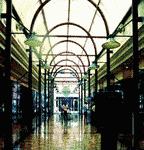gallery
1. a room or building for exhibiting works of art
2. a covered passageway open on one side or on both sides
3. a. a balcony running along or around the inside wall of a church, hall, etc.
b. a covered balcony, sometimes with columns on the outside
4. Theatrea. an upper floor that projects from the rear over the main floor and contains the cheapest seats
b. the seats there
c. the audience seated there
5. a long narrow room, esp one used for a specific purpose
6. Chiefly US a building or room where articles are sold at auction
7. Theatre a narrow raised platform at the side or along the back of the stage for the use of technicians and stagehands
8. Nautical a balcony or platform at the quarter or stern of a ship, sometimes used as a gun emplacement
Collins Discovery Encyclopedia, 1st edition © HarperCollins Publishers 2005
gallery

gallery, 1
1. A long, covered area acting as a corridor inside or on the exterior of a building, or between buildings.
2. An elevated area, interior or exterior, e.g., minstrel gallery, music gallery, roof gallery.
3. An elevated section of the seating area of an auditorium, esp. the uppermost such space.
4. In buildings for public worship, a similar space, sometimes set apart for special uses.
5. A service passageway within a building, or linking a building underground to exterior supplies or exits. Some service galleries also serve sightseers, e.g., the lighting gallery in the base of the dome at St. Peter’s, Rome.
6. A long, narrow room for special activities like target practice, etc.
7. A room, often top-lit, used for the display of art works.
8. A building serving such art needs.
10. Any raised working platform at the side or rear of a theater stagehouse.
12. (Brit.) A device, attached to a lampholder, for supporting a reflector, shade, etc.
McGraw-Hill Dictionary of Architecture and Construction. Copyright © 2003 by McGraw-Hill Companies, Inc.
The following article is from The Great Soviet Encyclopedia (1979). It might be outdated or ideologically biased.
Gallery
(1) A long, covered, well-lit space where usually one of the long walls is replaced by columns or posts and sometimes also by a balustrade. In the first half of the 16th century, especially during the baroque period, a new type of gallery was developed in European palace architecture: a spacious hall with a succession of large windows on one long wall. Beginning in the 17th century, such galleries contained the art collections of the palace owners. Later, art museums as well as their departments came to be called galleries. In modern architecture the gallery is an important functional element of gallery houses.
(2) An upper tier of a theater.
(3) Figuratively in Russian, a long row, a file (for instance, a galley of set type in Russian is called a galereia).
Gallery
(Russian, shtrek), a horizontal, underground mine passage that has no exit on the surface and that usually follows the vein or rock in which it is excavated, in which case it may be called a drift or rock drift. Various types of galleries are distinguished according to purpose, including primary (main roads), panel, horizontal, excavation, intermediate, transport, and ventilation galleries.
The Great Soviet Encyclopedia, 3rd Edition (1970-1979). © 2010 The Gale Group, Inc. All rights reserved.

